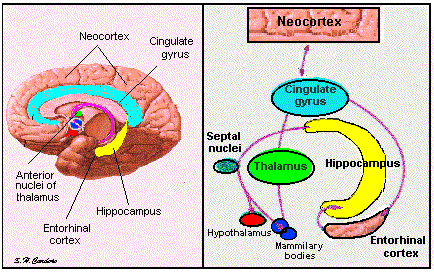

Theories on the Role of Brain Structures in the Formation of Emotions
|
|
At the end of the last century,
William James proposed that a person, after perceiving a stimulus that
somehow affected him or her, endures disturbing physiological changes such
as palpitations, shortness of breath, anxiety, etc.. It is precisely the
acknowledgment of these symptoms (by the brain) that creates emotion. Stating
it in a different way, we could say that physical sensations are the emotion.
In 1929, Walter Cannon refuted James's theory and advanced another one, that was soon modified by Phillip Bardand and became known as the Cannon-Bard theory which states that, when a person faces an event that somehow affects him or her, the nervous impulse travels straight to the thalamus where the message divides. One part goes to the cortex to originate subjective experiences like fear, rage, sadness, joy, etc. The other part goes to the hypothalamus to determine the peripheral neurovegetative changes (symptoms). According to this theory physiological reactions and emotional experience occur simultaneously. |
 Papez believed that the experience of emotion was primarily determined by the cingulate cortex and, secondly, by other cortical areas. Emotional expression was thought to be governed by the hypothalamus. The cingulate gyrus projects to the hippocampus, and the hippocampus projects to the hypothalamus by way of the bundle of axons called fornix. Hypothalamic impulses reach the cortex via relay in the anterior thlamic nuclei. |
The essential error of the Cannon-Bard theory was to consider the existence of an initial "center" for emotions (the thalamus). Soon enough, though, in 1937, the neuroanatomist James Papez would demonstrate that emotion is not a function of any specific brain center but of a circuit that involves four basic structures, interconnected through several nervous bundles : the hypothalamus with its mamillary bodies, the anterior thalamic nucleus, the cingulate gyrus and the hippocampus. This circuit (Papez circuit), acting in an harmonic fashion, is responsible for the central functions of emotion (affect), as well as for its peripheral expressions (symptoms). |
More recently, Paul McLean, accepting the essential bases of Papez proposal, created the denomination limbic system and added new structures to circuit : the orbitofrontal and medialfrontal cortices (prefrontal area), the parahippocampal gyrus and important subcortical groupings like the amygdala, the medial thalamic nucleus, the septal area, prosencephalic basal nuclei (the most anterior area of the brain) and a few brainstem formations.
2 of 4